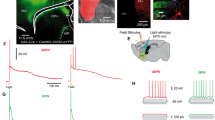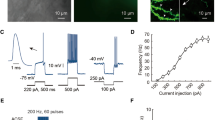Abstract
Spiny striatal GABAergic neurons receive most of their excitatory input from the neocortex. In culture, striatal neurons form inhibitory connections, but the lack of intrinsic excitatory afferents prevents the development of spontaneous network activity. Addition of cortical neurons to the striatal culture provides the necessary excitatory input to the striatal neurons, and in the presence of these neurons, striatal cultures do express spontaneous network activity. We have confirmed that cortical neurons provide excitatory drive to striatal neurons in culture using paired recording from cortical and striatal neurons. In the presence of tetrodotoxin (TTX), which blocks action potential discharges, the connections between cortical and striatal neurons are still formed, and in fact synaptic currents generated between them when TTX is removed are far larger than in control, undrugged cultures. Interestingly, the continuous presence of TTX in the co-culture caused striatal cell death. These observations indicate that the mere presence of cortical neurons is not sufficient to preserve striatal neurons in culture, but their synchronous activity, triggered by cortical excitatory synapses, is critical for the maintenance of viability of striatal neurons. These results have important implications for understanding the role of activity in neurodegenerative diseases of the striatum.



Similar content being viewed by others
References
Alberch J, Pérez-Navarro E, Canals JM (2002) Neuroprotection by neurotrophins and GDNF family members in the excitotoxic model of Huntington’s disease. Brain Res Bull 57:817–822
Bolam JP, Hanley JJ, Booth PA, Bevan MD (2000) Synaptic organisation of the basal ganglia. J Anat 196(Pt 4):527–542
Buss RR, Sun W, Oppenheim RW (2006) Adaptive roles of programmed cell death during nervous system development. Annu Rev Neurosci 29:1–35
Capurso SA, Calhoun ME, Sukhov RR, Mouton PR, Price DL, Koliatsos VE (1997) Deafferentation causes apoptosis in cortical sensory neurons in the adult rat. J Neurosci 17:7372–7384
Clarke PG (1990) Developmental cell death: morphological diversity and multiple mechanisms. Anat Embryol (Berl) 181:195–213
Coyle JT (1979) An animal model for Huntington’s disease. Biol Psychiatry 14:251–276
Dantzker JL, Callaway EM (1998) The development of local, layer-specific visual cortical axons in the absence of extrinsic influences and intrinsic activity. J Neurosci 18:4145–4154
Fishbein I, Segal M (2007) Miniature synaptic currents become neurotoxic to chronically silenced neurons. Cereb Cortex 17:1292–1306
Ghosh A, Carnahan J, Greenberg ME (1994) Requirement for BDNF in activity-dependent survival of cortical neurons. Science 263:1618–1623
Koliatsos VE, Dawson TM, Kecojevic A, Zhou Y, Wang YF, Huang KX (2004) Cortical interneurons become activated by deafferentation and instruct the apoptosis of pyramidal neurons. Proc Natl Acad Sci USA 101:14264–14269
Milnerwood AJ, Gladding CM, Pouladi MA, Kaufman AM, Hines RM, Boyd JD, Ko RW, Vasuta OC, Graham RK, Hayden MR, Murphy TH, Raymond LA (2010) Early increase in extrasynaptic NMDA receptor signaling and expression contributes to phenotype onset in Huntington’s disease mice. Neuron 28:178–190
Nakao N (1998) An increase in intracellular levels of cyclic AMP produces trophic effects on striatal neurons developing in culture. Neuroscience 82:1009–1020
Neely MD, Schmidt DE, Deutch AY (2007) Cortical regulation of dopamine depletion-induced dendritic spine loss in striatal medium spiny neurons. Neuroscience 149:457–464
Nicola SM, Surmeier J, Malenka RC (2000) Dopaminergic modulation of neuronal excitability in the striatum and nucleus accumbens. Annu Rev Neurosci 23:185–215
Papa M, Bundman MC, Greenberger V, Segal M (1995) Morphological anlysis of the development of dendritic spines in primary cultures of hippocampal neurons. J Neurosci 15:1–11
Ruijter JM, Baker RE, De Jong BM, Romijn HJ (1991) Chronic blockade of bioelectric activity in neonatal rat cortex grown in vitro: morphological effects. Int J Dev Neurosci 9:331–338
Segal M (1995) Dendritic spines for neuroprotection: a hypothesis. Trends Neurosci 18:468–471
Segal M, Greenberger V, Korkotian E (2003) Formation of dendritic spines in cultured striatal neurons depends on excitatory afferent activity. Eur J Neurosci 17:2573–2585
Snyder-Keller A, Tseng KY, Lyng GD, Graber DJ, O’Donnell P (2008) Afferent influences on striatal development in organotypic cocultures. Synapse 62:487–500
Tian X, Kai L, Hockberger PE, Wokosin DL, Surmeier DJ (2010) MEF-2 regulates activity-dependent spine loss in striatopallidal medium spiny neurons. Mol Cell Neurosci 44:94–108
Turrigiano GG (2008) The self-tuning neuron: synaptic scaling of excitatory synapses. Cell 135:422–435
Zhang LI, Poo MM (2001) Electrical activity and development of neural circuits. Nat Neurosci 4(Suppl):1207–1214
Acknowledgments
We thank Ms. Varda Greenberger for the preparation of the cultures. Supported by a grant from the Israel Science Foundation.
Author information
Authors and Affiliations
Corresponding author
Rights and permissions
About this article
Cite this article
Fishbein, I., Segal, M. Active cortical innervation protects striatal neurons from slow degeneration in culture. J Neural Transm 118, 445–451 (2011). https://doi.org/10.1007/s00702-010-0505-5
Received:
Accepted:
Published:
Issue Date:
DOI: https://doi.org/10.1007/s00702-010-0505-5




